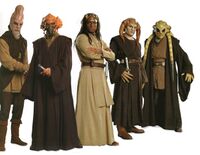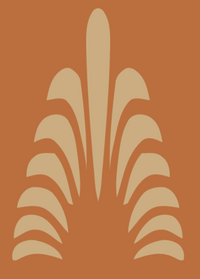Jedi High Council/Legends
The Jedi High Council, simply known as the Jedi Council, was the primary Jedi Council of the Jedi Order during the rule of the Galactic Republic. The High Council met in the southwest tower of the Jedi Temple on Coruscant.
The High Council was a group of twelve wise and powerful Jedi Masters who were elected to guide the Order as well as to serve as an advisory body for the Office of the Supreme Chancellor. The Council was made up of five lifetime members, four long-term members, and three limited-term members. This organizational structure had evolved from the earlier assemblies of Jedi Masters, and during the Great Hyperspace War may have been nothing more than an "inner circle" within the assembly. The Council originally had no set meeting place and met irregularly on planets such as Ossus and Alderaan. With the relocation of the Order from Ossus to Coruscant, the Council was permanently established in that world.
History of the High Council
Early history
The origins of the High Council could be traced back to the founders of the Jedi Order who assembled on Tython, with Jedi Masters Rajivari and Garon Jard holding week-long Jedi Councils with many peers to work out the best way to defend the Order from the dark side of the Force, but also to develop the Order's wisdom. This guiding body was structureless and fluid in nature, and had authority over the recruitment and training of new Padawans. Over time, this early Council evolved, and the notion of High Council took shape, more and more as the Jedi tied themselves to the Galactic Republic.[5]
The Council was established as meeting of several trusted Jedi Masters, to create a loose hierarchy in the Jedi Order.[6] As of the time of the Great Droid Revolution, a High Council had been formally created, making pertinent decisions by the time of the fall of Exar Kun.[7] Following Kun's death and the end of the Great Sith War, Jedi Nomi Sunrider was acknowledged as overall leader of the Jedi Order at the Conclave at Exis Station and held the title of Councilor on Coruscant, indicating she may have served on the High Council.[8]
Centuries later during the New Sith Wars, the High Council created and served in the Army of Light; a military organization designed to combat the Brotherhood of Darkness. Under the leadership of Lord Hoth, the Army of Light was successful in defeating the Brotherhood and brought lasting peace to the Republic. In the following months, the Galactic Senate ordered the disbanding of the Army of Light as one of the stipulations of the Ruusan Reformations. [source?]
The end of the Council
- "The Jedi believed in shades of gray...when there is only what benefits the Empire, and what does not."
- ―Darth Vader
As the Order was forced to militarize once again, Master of the Order Windu stepped down as leader of the Council so that he could serve more of a role on the battlefield. Grand Master Yoda took over as head of the High Council, remaining on Coruscant to better interact with the Office of the Supreme Chancellor and coordinate war strategy.[6] During this time, the High Council kept secret the location of the Prism on the 6th moon of Diab from the Senate and a few Jedi.[10] The make-up of the Council was in constant flux throughout the war, as Masters died or retired. In the final days of the war, the Council became increasingly suspicious of the Supreme Chancellor's office as mysterious coincidences began to suggest a connection with the mysterious Darth Sidious. Leading the investigations, Master Windu and Shaak Ti traced a trail back to the basement of 500 Republica, the apartment complex of some of the most prominent senators, including the Chancellor. Before the investigation could continue, Coruscant was attacked by General Grievous, forcing the Jedi to the surface. The ensuing conflict and capture of the Chancellor postponed the investigation indefinitely as the events of the next few days prevented Windu or the Jedi from returning to the trail. As Coruscant recovered from the attack and Palpatine was returned to his office, the Council's power was limited with the passage of the Enhanced Security and Enforcement Act.[11] Due to their suspicions of the Supreme Chancellor at the very least being influenced by the Sith Lord, and also for ulterior motives of separating the then-recently and informally included member Anakin Skywalker from Palpatine's influence, the Jedi High Council also opted to use Skywalker as a means to spy on the Supreme Chancellor to determine his activities. Although Skywalker's master and fellow High Council member Obi-Wan Kenobi opposed using Skywalker in that manner, believing that Skywalker was not a good fit for spying on the chancellor, he ultimately relented on the plan due to being outvoted.[12]

Increasingly troubled, the High Council was given news of the death of General Grievous at the hands of one of their own members, Master Kenobi. Along with Count Dooku's death, the Council believed this sufficient grounds to ask the Chancellor to step down from office and allow an election to take place. Motivated by the fear that he was a puppet of the Sith Lord, Master Windu took three other members of the Council with him to encourage Palpatine's resignation. However, Windu was informed by Knight Anakin Skywalker that Palpatine and Darth Sidious were indeed the same man; with this knowledge, the Masters set out to arrest the Sith Lord. Arriving at his inner sanctum, the four Masters confronted the Sith, with Windu's comrades Kolar and Tinn falling within moments. Fisto put on a brave fight but was cut down soon after. Alone now, Sidious and Windu fought a vicious duel, with Windu gaining the upper hand and disarming the old man, also redirecting Sidious' Force lightning back at the Sith, deforming the latter. Before Windu could deliver the killing blow, Skywalker entered the fight and, both deluded by Sidious's promises of power and fearing that Windu's act was also an act toward the dark side, disarmed Windu, with Palpatine capitalizing on this to induce a lethal dose of Sith lightning on the Jedi Master and tossing him out of the window.[3]
With four Council members dead and one, Anakin Skywalker, fallen to the Sith, the other members were unaware of what had transpired on Coruscant, though Grand Master Yoda had sensed a disturbance through the Force. To circumvent an organized Jedi reaction, Sidious used his position as Commander-in-Chief of the Grand Army to execute Order 66 across the galaxy. With all active clone commanders receiving orders to terminate their Jedi generals, nearly all Council members were wiped out in the sudden massacre. Meanwhile, Sidious had sent his new apprentice Darth Vader to the Jedi Temple to slaughter all within. With the Order in shambles, the High Council was disbanded with only three members surviving in exile.[3] Over the years, the last members of the Council were hunted down or otherwise died; Master Shaak Ti on Felucia,[13] Master Kenobi on board the Death Star,[14] and Grand Master Yoda on Dagobah. Yoda and Kenobi did not die before ensuring the continuance of the Order; both had a hand in training Luke Skywalker, the boy who would go on to take down the Galactic Empire and the Sith, and eventually, rebuild the Jedi Order.[15]
Known members
- Known Masters of the Order and Grand Masters are listed in bold.
Old Republic era
- Nomi Sunrider (c. 3986 BBY—), head of the Jedi Order (c. 3986 BBY—)
Rise of the Empire era

- Yoda (—19 BBY), Grand Master of the Jedi Order (—4 ABY), and Master of the Order (22 BBY)
- Obi-Wan Kenobi (22–19 BBY)
- Anakin Skywalker (19 BBY), representative of the Supreme Chancellor (19 BBY)
Sources
- Cracken's Threat Dossier (Indirect mention only)
- Star Wars: The Visual Dictionary (First mentioned)
Notes and references
- ↑ 1.0 1.1 1.2 1.3 1.4 1.5 1.6 1.7 The Jedi Path: A Manual for Students of the Force
- ↑ Star Wars: The Old Republic
- ↑ 3.0 3.1 3.2 Star Wars: Episode III Revenge of the Sith
- ↑ Dark Nest III: The Swarm War
- ↑ Star Wars: The Old Republic Encyclopedia
- ↑ 6.0 6.1 The Complete Star Wars Encyclopedia
- ↑ File:SWTOR mini.png Timeline 10: The Exar Kun War on The Old Republic's official website (article) (backup link)
- ↑ Jedi vs. Sith: The Essential Guide to the Force
- ↑ Darth Vader and the Ghost Prison 2
- ↑ Darth Vader and the Ghost Prison 3
- ↑ Labyrinth of Evil
- ↑ Star Wars: Episode III Revenge of the Sith novelization
- ↑ Star Wars: The Force Unleashed
- ↑ Star Wars: Episode IV A New Hope
- ↑ Star Wars: Episode VI Return of the Jedi